The Witcher 2: Assassins of Kings preview
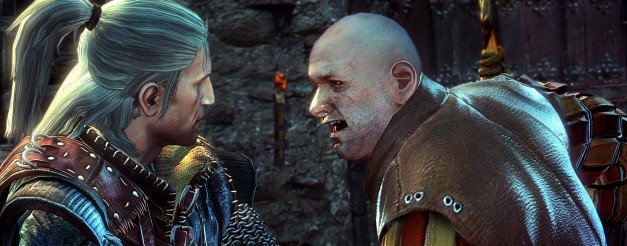
Geralt of Rivia will not, perhaps, be remembered as one of the world's great lovers. Not after those antics in the first game, where his sexual conquests were essentially reduced to a Panini sticker-book collection. You can imagine him sitting in the tavern with it, bragging to the dwarves. “Had her! Yep, and her. And... hang on, how did Glen Hoddle get in there?”
Precisely how sex will be dealt with in The Witcher 2: Assassins of Kings is still unclear. My recent trip to CD Projekt Red's Warsaw studios to see the game did briefly touch on the subject, however. More of that in a moment, but I was assured that “sex and eroticism will be introduced in a much more realistic, involving, and mature way.” The abolition of conquest-cards would be a pretty good start.
What we do know is that The Witcher 2 is an RPG. And for any developer, particularly one working on such a dialogue-heavy genre, getting the script right is paramount. Yet however beautifully written, that script is only as convincing as its delivery.
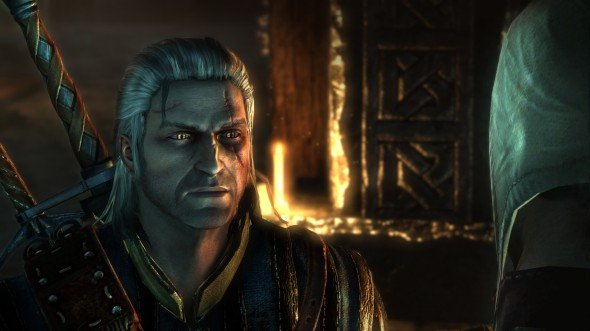
History is littered with great games that lacked convincing and consistent voice-acting, and it's not just lowerbudget titles that suffer. Oblivion's NPCs were railing in stentorian tones about the end of the world one minute, and blathering about mud-crabs the next – sometimes in a different actor's voice. It's such an incredibly important element to nail if you want your game to suspend disbelief and draw players into its fantasy.
Five minutes into my guided tour of The Witcher 2, and it's plain that CD Projekt are refusing to scrimp on their voice budget. The first couple of characters I meet are a convincingly Scottish dwarf, and an imperious public-school Elf. Their dialogue isn't laboured and caricatured, as it is in so many RPGs. It sounds natural, and breathes life into the characters onscreen. As Jan Bartkowicz, the game's scriptwriter and my guide to Witcher's kingdom of Temeria, confirms: “It's an international effort. There's a British voice studio we're working with who are very good, and we moved part of our localisation team there to make sure they get it right.”
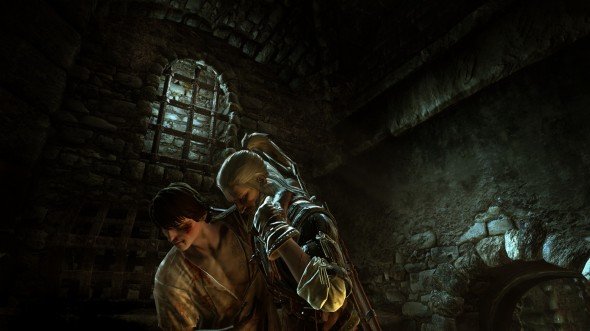
Beautiful people
It helps, of course, when the characters themselves look the part. And in The Witcher 2: Assasssins of Kings, they very much do. A lot of care has been lavished on designing Temeria, along with the various denizens that inhabit it. My hour-long exploration of the Dwarven city of Vergan and the forest surrounding it clearly demonstrated that CD Projekt want their game to look as good as they can possibly make it. The wooded scenes are stunning, especially at sunset, when the sun's dying rays filter through the branches in a honey-rich display of specular lighting.
The biggest gaming news, reviews and hardware deals
Keep up to date with the most important stories and the best deals, as picked by the PC Gamer team.
Check the screenshots. These aren't doctored images, the game really does look this good. When quizzed about whether they'd consider porting Witcher 2 to console, the answer was pretty resolute: “We're making a PC game. We're making the best PC game we can.”
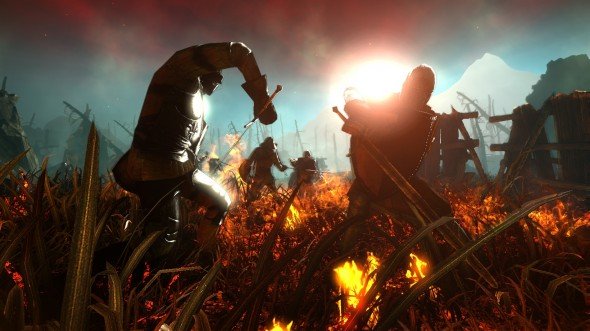
Every interior and exterior has a character of its own. Early on in the demonstration, Jan took us into the town's tavern, and I was greeted with a warm sense of atmosphere; the sound of clashing steins, a rich, authentic folk soundtrack, and a general sense of hubbub and Dwarven welcome.
Geralt himself, moody star of the first Witcher game, carries a brooding sense of menace in his voice, his actions, his movements and his looks. And getting all these elements riffing together to create a thrilling sense of reality isn't something that happens by accident. It's a mantra that the team lives and works by.
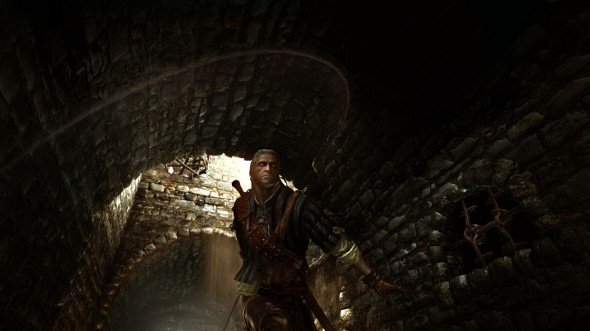
My demo took in the early steps of one of the game's many sidequests, which began with a conversation with an Elf stationed at Vergan. Although its a dwarven city, an uneasy three-way alliance between humans, elves and dwarves has led to the place becoming a cultural melting-pot where all three races are present. Where the races overlap, there are tensions. The elven quest-giver spoke of a series of murders that were occurring, and could Geralt look into it? After a brief nosey around the tavern, which was packed with gambling minigames, Jan took us out into the woodlands to inspect the corpses for ourselves.
In short order, Geralt was attacked by bandits, and here I got to see the combat in full swing. The Witcher 2 is no mere button-masher – it's way more tactical. It soon became obvious that a willy-nilly sword-waving approach is just going to get you killed.
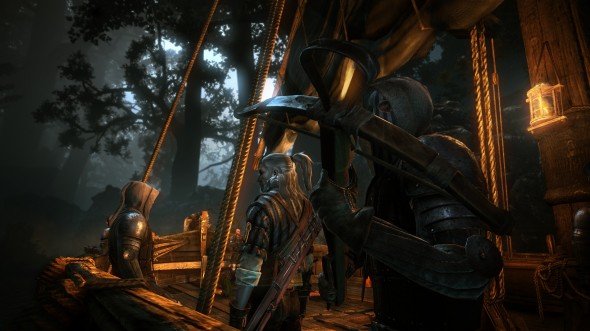
Attacking Geralt was a band of melee combatants, an archer, and a rangeddamage spellcaster. Fighting numerous enemies in this game is tough, and requires plenty of blocking and rolling away when they attack simultaneously. Jan would cast an area-of-effect lightning spell, dart in for an attack, then flank the group to lay some damage onto the enemy caster, switch targets to keep the melee at bay, dart back to hit a single combatant with a heavily-damaging fireball, and so forth. Focusing exclusively on a single enemy means you leave yourself wide open to attack by others, so a kind of kiting approach is required to keep multiple foes at bay.
But you still need to assess who's dealing the most damage, and take him down in short order. In this case, it was the spellcaster. On a couple of occasions, Jan actually managed to line the caster up in front of the enemy archer so he took damage. But in general, it seemed to be a case of drawing the greater melee away from the ranged attacker to leave him exposed, before darting around to deliver a flurry of blows. The final enemy left standing was a shieldbearer, and he was the toughest of the bunch. As a natural defender, you have to wait for him to strike, and deliver the riposte when his guard is down.
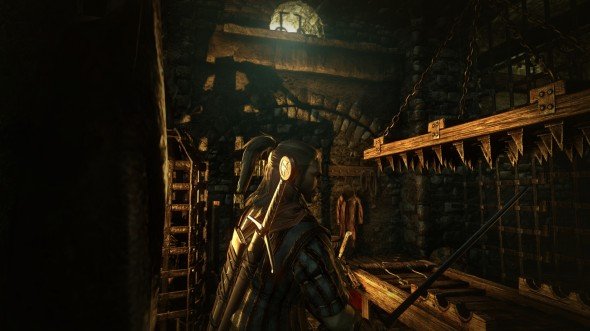
I also saw a few of Geralt's spells in action. Of particular interest was his fire-trap spell, which involves placing a ward on the floor. Enemies who step on it get flamed. Levelling up the ability, however, enables you to chainlink further wards, at which points lines of fire are drawn to connect the wards together. Placing three wards equidistant from each other creates a great triangular trap-area in which any foe who crosses the line takes fire damage. It looks like a great way to start a fight, and I can envisage indulging in almost BioShock 2 levels of devious trap-placement, arranged to weaken foes before drawing them into an encounter with naked steel.
Spooky
Continuing the quest, Jan took us out of the woodlands and into some haunted ruins, where a quest-marker showed where the bodies were to be found. At this point, Geralt sheathed his steel sword and drew his silver blade, as conventional weapons are no good against spirit foes. In no time he was swamped with wraiths, which Jan deftly dispatched.
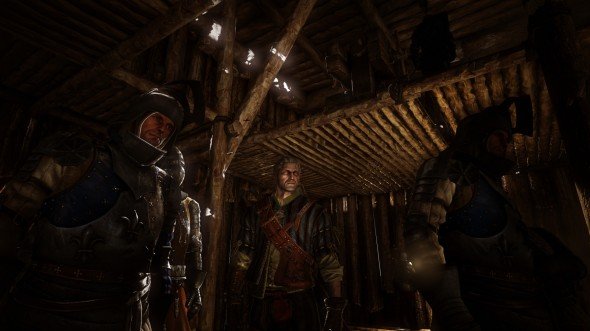
Down in the crypt, we had to hunt through cloth-wrapped corpses to find the bodies of the fallen soldiers. What followed was a kind of detective minigame examination of one of the bodies, to try and piece together what had actually happened. His back was deeply raked with claw-marks, he had a clutch of hair in his hands, a look of terrible pleasure on his face, and wrapped with the corpse was a page of poetry written by the foppish Dandelion, Geralt's bard associate. From this, Geralt concluded that sexy demons were involved, and off we toddled to look for our succubus.
Heading back to the inn, we encountered Dandelion, who tried his new song of human and dwarven camaraderie out on Geralt. It's a bit... cringe-worthy. “You like it?” asks Dandelion, excitedly. Geralt frowns, and after a pregnant pause, says: “It rhymes.” But we need Dandelion's skills for this quest. Geralt's plan is to lure the local succubus out of hiding using Dandelion's poetry, and they agree to meet at the nearby burned-out village at sundown.
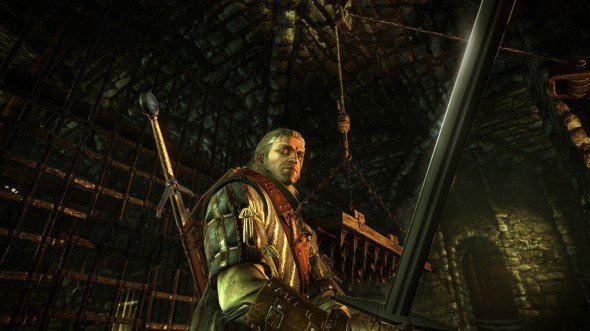
Suck my what?
Stepping us out into the street, Jan showed me the Meditate function. This has two key functions: to pass the time, if you need to wait for a specific timed event, and to perform alchemy. One of the changes since the first game is that you no longer need the presence of environmental features, such as a fire, to perform alchemy; you can combine ingredients anywhere, which reduces the trekking required to concoct potions and the like.
After sunset, we travelled to the edge of the village where the succubus was rumoured to dwell, and met with Dandelion. What followed was a choice: should Geralt tackle the succubus himself, or let Dandelion do the talking? Jan chose Dandelion, and a nice little poetry minigame ensued, where the player is presented with lines of verse, and has to order them into something that flows and make sense.
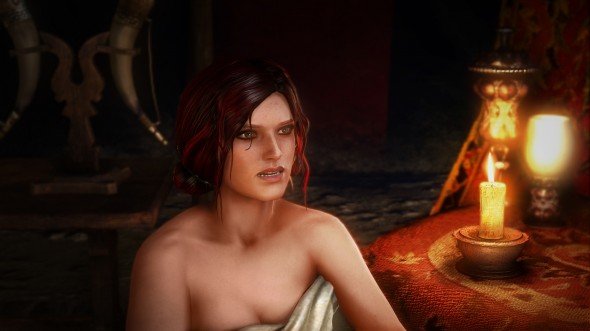
He sang the poem, the succubus appeared, and our hapless fop headed down to her lair for some demonic loving. Time passed. Geralt became concerned, and entered the subterranean boudoir himself, where we found Dandelion in a post-coital daze. After a conversation with the succubus, it appears she's not to blame for the killing of the soldiers, but a new clue was provided as to who the real perpetrator might be.
Not bad for a sidequest: packed with detail and character, and not just another slay-and-loot time killer. I sincerely hope that the sense of playfulness I saw in my brief time with The Witcher 2 extends to the criticalpath quests too, as it could really make the game stand out from the crowds of hack-and-slashers. But one thing is for certain: a lot of love is going into Geralt's second adventure.

Al's games-and-tech quilling began on PC Gamer Specials magazine in the year 2000, before moving on to PC Format and then out into game development. In the last 23 years he’s reviewed a bajillion games and assorted pieces of hardware, spent 13 years in game dev, built PCs, dry-stone walls, and ebikes, and logged 1000 hours in Fallout 76. His current obsessions are tiny PCs and sledgehammering every single object in Dysmantle into its constituent parts.

